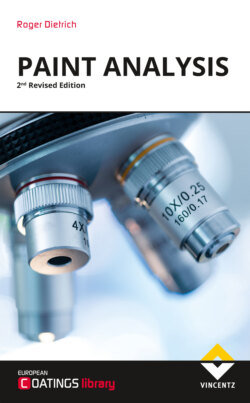Читать книгу Paint Analysis - Roger Dietrich - Страница 31
На сайте Литреса книга снята с продажи.
13.2.1.3 Example 3: Random sampling of binders
ОглавлениеA water-based polyester paint binder is delivered to a paint manufacturing company by a tank truck. During the unloading process into a storage tank of the manufacturing company representative sample have to be gathered for quality testing. This task cannot be calculated by stochastic methods. Being representative here means taking samples from different areas of the tank from the top, from the bottom and at the outlet pipe.
Figure II.8: Tank transporter delivering water-based polyester binder
Figure II.9: Sampling a water-based polyester binder consignment at the outlet pipe of a tank transporter
Figure II.10: Dried film of a water-based polyester binder at the outlet pipe of a tank transporter
A few parameters have to be realized if sampling a delivery of this type:
A water-based binder is a suspension. This suspension can settle into layers of different density inside the tank. During transport over the road it is reasonable to assume that this suspension is well be agitated in the tank by the movement of the vehicle and thus should be homogeneous upon arrival. Therefore, a sampling shortly after arrival of the truck is recommended.
Depending on the outside temperature some binder can dry at the top of the tank inside walls. A dried binder suspension is like a rubber material and cannot be homogenized into the suspension. It may fall into the suspension without dissolving and “contaminate” the load (see Figure II.10). This dried raw material can cause hidden failures during paint production ending up in paint specks once the coating is applied. So, you would want to find these rubber pieces during quality testing.
Therefore, different levels inside the tank have to be sampled for each delivery. This can be achieved by a dipping vessel which is lowered into the tank down to the desired levels (which have to be measured by a weighted tape measure!). Once the dipping vessel reaches the targeted depth it is opened until it is filled and then hauled up. Three different levels have to be tested at least: the bottom of the tank, the top of the suspension load and one level in between. This is the minimum, but more levels would be desirable. The subsequently drawn sample have to be mixed again to be collected in one aggregate sample which is finally used for the desired testing procedures.
Sample numbers depend on the local circumstances: If the tank truck has only one hatch the three samples from the top, an intermediate layer and the bottom must be carried out from that access and from the outlet pipe. If there are more hatches samples should be drawn from all the hatches and the outlet pipe.
Sampling over the whole-time scale of the unloading process is recommended. Why? See Figure II.10. This dried, rubber like polyester binder material came out at the very end of the sampling process. A single sampling at the beginning or a double sampling at the beginning and during the unloading would have missed this.
The amount of the final aggregate sample is determined by the testing procedures and analytical methods.
Another technique to achieve a random sample is stratified sampling . This means the population (e.g. a delivery of a filler) is split into several portions. After that aliquots of each subdivision are randomly drawn and combined to one aggregate sample. If you look at Figure II.11 each tray of ten bezels represents a subdivision of the whole lot. A stratified sample is achieved by e.g. taking out one bezel randomly from each tray.
Cluster sampling is a slight variation of this method. This means again dividing the whole population which has to be tested into equal subdivisions. But in contrast to stratified sampling all bezels of a certain amount of randomly selected trays are saved for the analysis. At last representativeness can also be achieved by selecting every nth bezel just by counting (for example every fifth bezel counting from the top of the stack of trays in Figure II.11 to the bottom). This procedure is called systematic random sampling .
Figure II.11: A rack of coated automotive interior parts
